HALL OF SWORDS
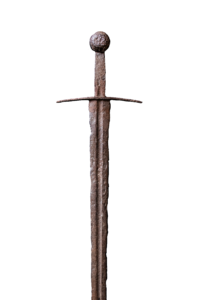
One-handed estoc sword
- Type XVI
- About 1300-1350
- Wrought iron
- Blade length: 84.5 cm
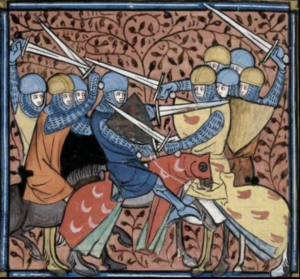
Ebroin, victor over the Austrasians, The Great Chronicles of France, 1332-1350
Take a good look!
Types of swords based on Oakeshott’s classification: can you find the ones on display?
Ewart Oakeshott (1916-2002) was a British historian, the author of many books about medieval weapons and armour. The method he used to classify medieval swords is based on his own visual, aesthetic and comparative experience. His practical experience led him to developing a simple form of typology for medieval swords, based on the shape and the cross section of the blade, and taking into account variations in the hilt (pommel, grip, cross-guard). His works are a unique resource for medieval weapons. They are consulted by all the specialists and collectors of medieval weaponry.
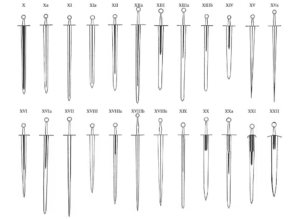
Swordsmen struck vulnerable parts of the enemy that were unprotected by chain mail (the legs and arms) with the sword’s edge, while the estoc or tuck sword refers to the sword’s point.
This particular weapon could be used both as a slashing sword and as a sharp thrusting sword. This type of blade was developed in response to reinforced chain mail, which was improved in the early 14th century.
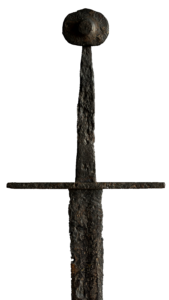
Two-handed sword
- Type XIIa / XIIIa
- 1300-1350
- Wrought iron
- Blade length: 95 cm
- Solingen, Germany
Take a good look!
These details inlaid with brass can be seen on the sword: can you find them?
The long blade is balanced by a large pommel. On both sides of the blade’s forte (strong part), we can see patterns inlaid with brass. They are probably the trademarks of forges in Solingen, Germany, which had a great reputation in the Middle Ages and sold their wares all over Europe.
1 – Templar cross (circled)
2 – S Gothic from Solingen (circled)
3 – Horizontal heart
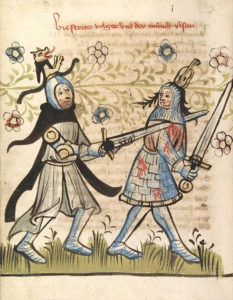
Volker von Alzey (on the right) fighting the monk Islan de Bern, Der Rosengarten von Worms, Codices Palatini Germanici 359, about 1418
This long sword, also known as the « great sword of war », was held in both hands, which explains the length of the hilt (21 cm). The part of the sword between the cross-guard and the pommel was once protected by leather and wood.
The point on this kind of sword, which appeared from the 12th century, was not very sharp. Swordsmen struck vulnerable parts of the enemy that were unprotected by chain mail (the legs and arms) with the sword’s edge.
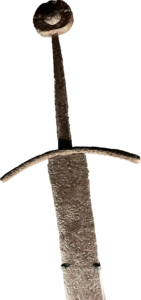
Two-handed estoc sword
- Type XIII
- 12th century
- Wrought iron
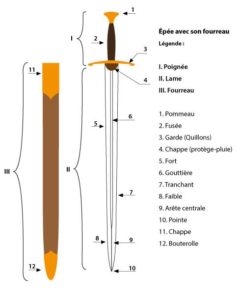
Sword (detail). Illustration: « Bruno Péronnet »
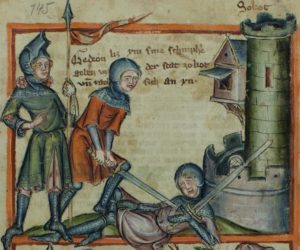
The Human Mirror of Salvation, 1325-1375, Karlsruhe, Germany
This sword with a curved cross-guard had a sharp point. It is a thrusting sword, aimed at delivering a blow with its tip, which is very prominent here, in contrast to blows from a sword’s cutting edge. The thrusting sword could penetrate chain mail. This is an early variant of the type XIII, which developed further in the 13th century. The large hilt shows that the sword was held in two hands.
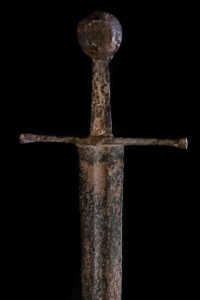
One-handed sword
- Type XII
- About 1225 – 1275
- Wrought iron
- Blade length: 106.5 cm
- Toulouse region
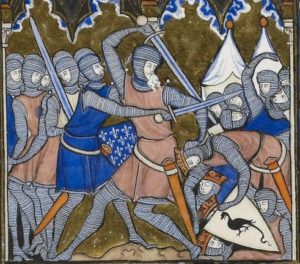
Saint Louis Psalter. About 1270. Paris. BnF
Take a good look!
Details from the decoration engraved on both sides of the sword: in the upper part of the forte (strong part of the blade), we can see a series of symbolic decorations engraved with three arrows and a bird. The bird is probably a falcon in attack position with its wings folded forwards and its claws set apart to capture its prey. Only a lord had the right to hunt with a falcon.
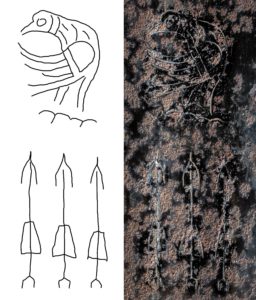
The point on this kind of sword was not very sharp. Swordsmen struck vulnerable parts of the enemy that were unprotected by chain mail (the legs and arms) with the sword’s edge.
Here the round pommel provides a counterweight and balance to the blade. Quite exceptionally, tiny fragments of wood and leather were found on the hilt.
Type XII swords are shown on bas-reliefs, paintings and tapestries from the early 13th to the mid-14th century. They were the most widely used swords or at least the ones that have been found in the largest numbers.

